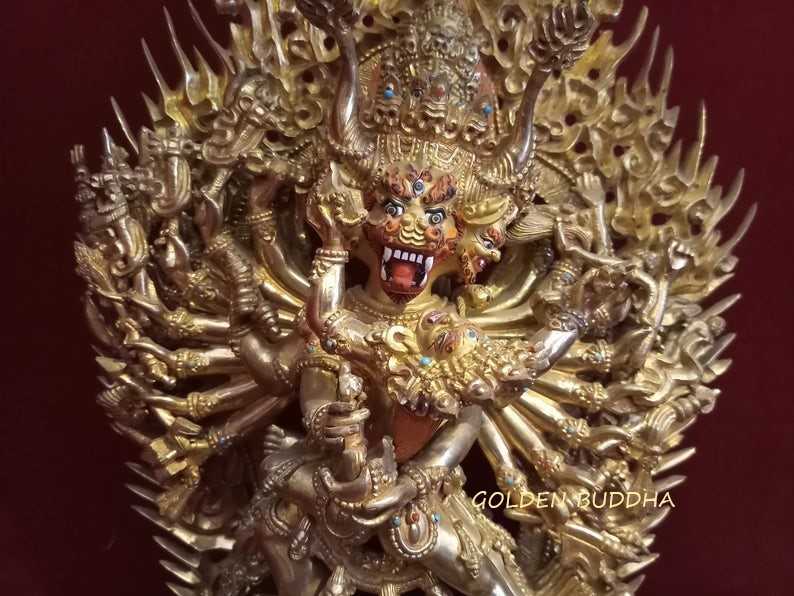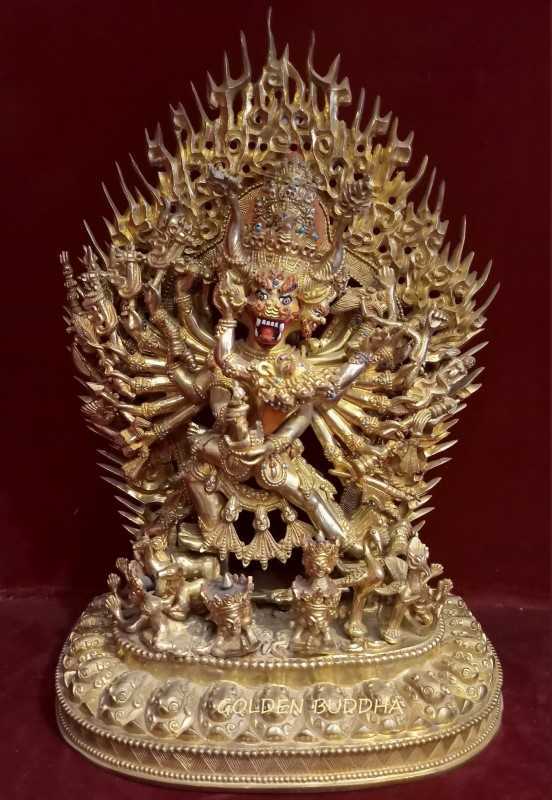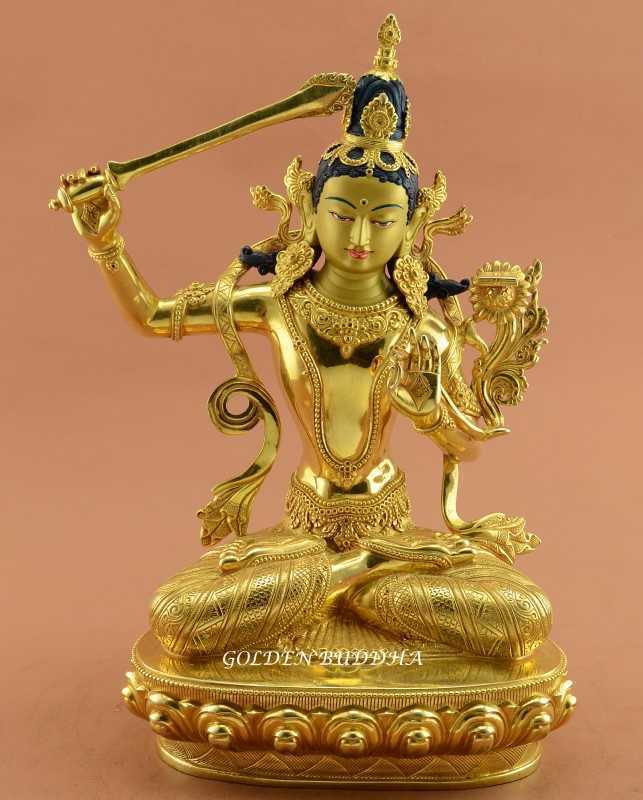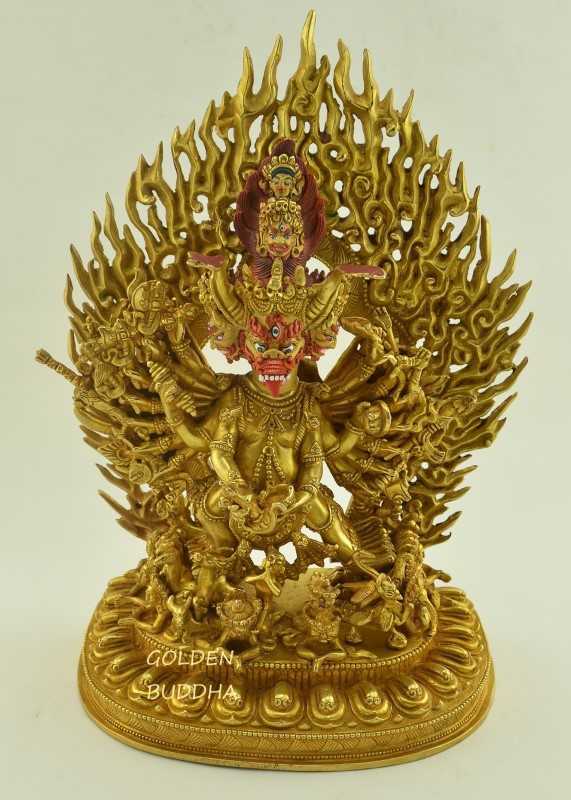Yamantaka Statues represent the Buddhist concept of wisdom in the most fearsome form imaginable. A Yamantaka statue has 9 heads with wrathful countenance, 34 arms holding sharp tools and gruesome objects. Additionally, his 16 legs trample on the corpses of negativity. Indeed, the most frightening aspect of Yamantaka is a buffalo head featuring large horns creating the illusion of the devil.
So fierce is Yamantaka that he has defeated the “Lord of Death” – Yama – to enter the ultimate bliss of supreme enlightenment. Buddhist art enthusiasts find Yamantaka statue features intriguing and inspirational. However, Yamantaka is also an effective means to obtain spiritual realization.
Yamantaka Statue Meaning
Yamantaka has synonymous names such as Megh Samvara and Vajrabhairava. Vajra is the Sanskrit word used for “lightening bolt” and Bhairava is the term for “terrifier”. Additionally, the meaning of Yamantaka “Destroyer of Death” combines Yama – “The Lord of Death” and antaka – “destroyer”.
Tibetan Buddhists use Yamantaka as a meditational deity to escape from the cycle of rebirth known as samsara. However, this is not to be confused with obtaining immortality. By breaking the cycle of samsara, successful practitioners will not experience rebirth. As a result, they have defeated death to become Buddhas.
Wrathful Embodiment of Manjushri
Yamantaka is the wrathful embodiment of the Buddhist “God of Wisdom” – Manjushri. Although it seems perplexing to those who are unfamiliar with Mahayana Buddhism, accomplished bodhisattvas can take any form necessary to ease the suffering of sentient life. Therefore, high level bodhisattvas such as Manjushri certainly can assume extreme appearances such as Yamantaka.
Buddhist sculpture symbolizes wisdom using fire. For example, Peaceful Manjushri statues represent wisdom with a flaming sword. However, the sword is not to be confused with using brute force. Instead, the sword of wisdom represents the gentle annihilation of ignorance using intricate means.
Wrathful Manjushri statues also symbolize wisdom using fire. Yamantaka is indeed surrounded by the flames of wisdom protecting him from negativity. Additionally, the head of Manjushri sits above the buffalo horns reflecting the true meaning of Yamantaka.
Yamantaka Sadhana
Buddhists believe that the root of all suffering is ignorance. Furthermore, the cure for ignorance is wisdom which enables practitioners to understand the true nature of all phenomenon. However, the illusion of self is a very powerful force and sometimes shock therapy is a most effective cure.
A Yamantaka statue presents a fierce visualization used to overcome the inner demons created by ignorance – especially anger and hatred. Successful practice will prepare practitioners to escape samsara during the short period of time that exists between the end of their mortal life and their next rebirth.
Yamantaka practice requires initiation and must be conducted under the guidance of a qualified teacher. If so, after many years of meditative practice the ultimate goal may be achieved.

Tibetan Legend of a Yamantaka Statue
Yamantaka has 9 heads with fearsome expressions, however its primary head is that of a buffalo. As a result, the buffalo head has large horns which give it a demonic appearance. This appearance of Yamantaka is the result of a mythical confrontation that occurred between a meditating monk and two thieves.
In ancient Tibet, there was a hermit monk who resided inside a cave for permanent meditative retreat. One dark rainy night, the monk was in deep meditation inside the cave when two thieves burst inside with a stolen water buffalo in tow. The monk asked the intruders to leave immediately so he could continue, but the thieves feared they would be caught and beheaded the buffalo and also the monk.
However, the monk was a high level practitioner with special siddhis. Additionally, he was enraged that the thieves had interrupted him at a crucial stage of practice. Therefore, he took the head of the buffalo and placed it on his shoulders, then he killed the thieves and went on a murderous rampage throughout the country. The Tibetan people were so afraid that the monk became known as the “Lord of Death” – Yama.
The Tibetan people prayed to the deity Manjushri, asking him to come and save them from the Yama. To accomplish the task, Manjushri assumed the form of Yamantaka – the “Conqueror of Death”. As a result, the anger and hatred that had consumed the monk was defeated by the wisdom of Manjushri. In the end, the light of wisdom overcomes the darkness of ignorance using the most effective means.




